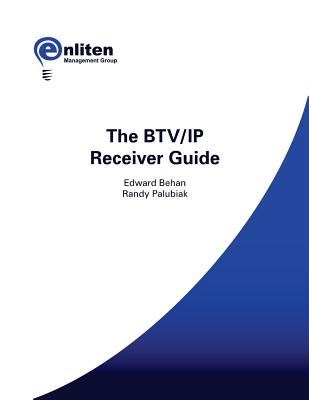You are here
Back to topThe BTV/IP Receiver Guide (Paperback)
Email or call for price
Description
What is the Purpose of this Guide? In recent decades, corporate and employee communications and training have become increasingly important to organizations and enterprises in building and maintaining healthy productivity, strong corporate cultures and continuous growth. Video-based technologies that support these efforts have grown increasingly sophisticated and ubiquitous. In particular, satellite-based business television (BTV) and interactive distance learning (IDL) networks, employing one-way video transmission, have been widely adopted and successfully utilized by numerous organizations. This Guide specifically focuses on the key component of a BTV/IP network: the satellite receiver. It provides information and guidance on available, proven IP receiver technologies, the manufacturers who provide them, and touches on related components of BTV/IP network architecture. What is BTV/IP? BTV/IP stands for Business Television over Internet Protocol. Unlike traditional BTV, where the digital video signal is distributed to televisions from the satellite receiver, BTV/IP video content can be distributed to both televisions and local area networks (LAN). As such, BTV/IP can leverage computer networking technologies to enhance or extend traditional BTV services, with applications such as video on demand, video streaming to the desktop, dynamic digital signage, and real-time testing and measurement of viewer participation. Why Does the Guide Focus on the Receiver? More than any other component, the receiver often represents the largest capital expenditure of a typical satellite network. The receiver's reliability and performance has had a major impact on the operational success of BTV networks. This is truer with BTV/IP, where the receiver must seamlessly integrate with corporate local area networks. Enliten conducted extensive research of the various IP products available globally to identify which receivers meet the requirements of the satellite-based BTV/IP enterprise market. The BTV/IP receivers are segmented into the following categories: BTV/Media Gateway products designed exclusively for this market, offering: Playback of NTSC video to a television Streaming of IP video to a LAN Hard drive for storage Robust router functionality Middleware for BTV-specific applications IP Satellite Routers: Satellite receiver with robust router functionality, intended for deployment in a large enterprise (to interface within a LAN) environment IP Satellite Receivers: Satellite receiver with an IP network interface, intended for the Small Office Home Office (SOHO) environment Most of the BTV/IP receiver products covered in the Guide are currently deployed in the field. They are represented through established sales channels and can be purchased directly from the manufacturer by self-managed networks. Some of the products in this Guide do not meet the requirements of any one category. These products have been placed in the category deemed most appropriate. What are the Other Components of a BTV/IP Network? In developing services for a BTV/IP network, additional components besides the satellite receiver need to be considered. These components are addressed in the Network Architecture section and include IP encapsulators; low data rate encoders; network management systems; remote hardware; peripheral storage devices, dedicated players (for digital signage applications); interactive distance learning systems; and return path interfaces.

